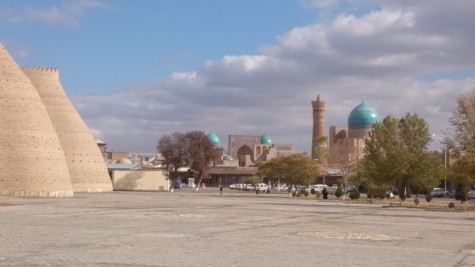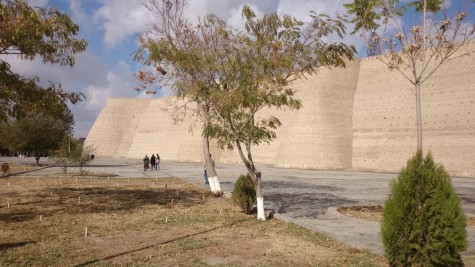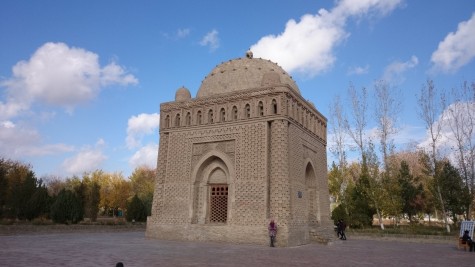 Last day in Bukhara. First, some logistics. We needed to work. And we needed a train ticket to reach out next destination, Samarkand. The work was easily accomplished. The train ticket was a little trickier. Our hotel told us that there was a ticket station near the Italian restaurant where we ate yesterday, next to “city lights.” Cindy surmised that city lights meant traffic light. Upon reaching the traffic light, there was no ticket office to be found.
Last day in Bukhara. First, some logistics. We needed to work. And we needed a train ticket to reach out next destination, Samarkand. The work was easily accomplished. The train ticket was a little trickier. Our hotel told us that there was a ticket station near the Italian restaurant where we ate yesterday, next to “city lights.” Cindy surmised that city lights meant traffic light. Upon reaching the traffic light, there was no ticket office to be found.
We went into random shops to ask where the ticket office was. No one spoke English, and not even my wonderful “choo choo” sound effect, accompanied by a horn-pulling arm motion, helped us communicate our question. Finally, we went back into the Italian restaurant, where Cindy drank coffee by herself for an hour the previous day, and asked where the ticket office was. Between three of the friendly waiters, we had a semi-accurate answer that was communicated with wild gestures. The waiters and their gestures were correct, and we soon had our tickets to Samarkand.
A quick note, the inflated currency makes learning numbers difficult. It’s one thing to learn one, two, three in whatever language. It’s another to learn one hundred twenty-three thousand eight hundred. With numbers so large, it’s easier for people to just write prices down for us to read, or punch them into to ubiquitous calculators.
On our first day, we noticed that there was a large park that extended from the end of the Ark to who knows where. Our Lonely Planet map confirmed its size and also showed that a couple of mausoleums were in the park, and that a bazaar was right outside of the park. Alrighty then, let’s go to the park for our last day. But first, I needed to take a picture of the Ark (above). To the left of the walls of the Ark. To the right is Bukhara proper. Like I said, beautiful place. Here’s the Ark, again.
Also in the park was the Avenue of Memories, a site that commemorated all the Uzbek deceased from World War II. Note, World War II is serious here. The then Soviet Union suffered the most casualties of any participating country. Everywhere that was part of the USSR at the time has war wounds, and they do not forget them. If you’re curious, the estimated USSR death toll was 27 million. The estimated Chinese death toll was 15 to 20 million. The estimated USA death toll was 419,000 (all numbers from the always correct Wikipedia).
The bazaar adjacent to the park introduced us to something we had not experienced much of in Central Asia, spices. There were mountains of them. Bright, yellow, orange, and red. “Why aren’t any of these in the food we eat?” Cindy asked aloud. It’s certainly curious. For somewhere that was right in the middle of the Silk Road and the spice trade, Uzbekistan only seems to have retained two for itself–salt and pepper. What are they doing with those pillow mounds of spicy happiness?
After lunch, Cindy decided to catch up on work and I took a bath. Or more like a bath was given to me. Five years before, I went to my first hammam in Turkey, where a large, hirsute Turkish man treated my body like a piece of meat that needed tenderizing. The Uzbek hammam was similar in that my body became property, but it was more tug and pull than punch and smack. At one point, the young guy stood behind me while I was laying face down, hooked his legs around mine, and pulled up on my arms as if he were performing a professional wrestling bow and arrow. It’s supposed to be good for me.
The finishing touch was a ginger paste that he rubbed over my torso. He put a glob in my hand and told me to put it, ahem, “everywhere.” I obliged, and he walked me to the natural sauna and told me to stand underneath the vents. What he did not tell me is the ginger paste BURNS. And it burned… everywhere. I knew an ice cold water splash down was coming and it could not come soon enough. When the guy mercifully came like twenty minutes later, I threw off my towel and told him to toss that water EVERYWHERE.

 Español
Español

Oh my I could “see” way too much EVERYWHERE while reading that! Ack! My eyes!
Relax, it feels better now.